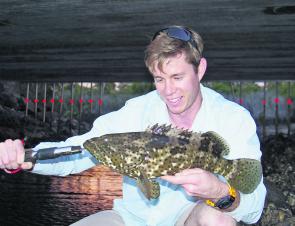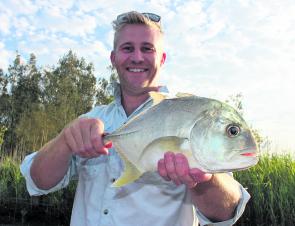I’m hoping everyone reading this has had an enjoyable and relaxing holiday, with the added bonus of some well-deserved time off spent fishing!
As predicted in last month’s column, the warm water really fired up many of the Richmond River’s fish species, with mangrove jacks, giant trevally and some big estuary cod featuring in catches. This time of year is great to target these more tropical types, although they do require a different approach to your average line dangler looking to score a feed of whiting or flathead.
Fishing prime times and tides early in the morning (the crack of dawn), or late at night will dramatically improve your chances, as they seem to react badly to excessive boat traffic. Live bait is generally the go, as it is a more effective and cheaper option than lures, especially around the oyster-covered rock walls and bridge pylons. Mind you, I have had some success sneaking up North and Emigrant creeks lately, throwing lures into any drowned timber and bankside cover that I can find.
The timber seems to be slightly more forgiving than the rock walls and I while I can’t seem to extract a decent jack, despite some monumental bustoffs I have managed to catch several thumping cod and quite a few good-sized trevally.
The best lures so far for have been soft plastics such as the TT Lures’ Snake Head, or the new Prawnstar. Both are remarkably snag resistant, allowing them to be cast right into heavy cover. I start by working the outside of the snag with a couple of casts, before working up enough courage to pitch one right into the danger zone.
Providing I don’t get snagged on the first couple of exploratory casts, that throw into the deepest part of the snag will often get crunched as soon as I start my retrieve. From then on it’s simply a brutal tug-a-war to decide who wins. There is no finesse in this style of fishing and the drag-’em-out fights and monumental clean-ups is what makes it so addictive.
I use an almost totally screwed up drag, a 6-8kg rod with 20lb braid and 40-50lb fluorocarbon leader. Knots must be perfect, as they will definitely be put to the test. A 12-turn Bimini with a Bristol Knot connects the braid to the leader. These can be tied quite quickly and give almost 100% knot strength, while a drop of Loons Knot Sense is used on every connection to ensure there are no weaknesses for a fish to exploit.
If just looking for a feed of fish, the Richmond River has been crawling with plenty of tasty whiting and flathead. While I haven’t seen a decent bream in a while, I’m not really complaining as nothing beats a feed of the first two species. I prefer to fish the first couple of hours of the outgoing tide as they congregate around the dropoffs and channels.
Most people don’t think of whiting as voracious predators, but they can be very aggressive at this time of year when the prawns are running. An excellent way to fish for them is to use poppers or small stickbaits on the runout tide, working them quite forcefully and quickly. A bit of wind chop on the water always seems to help, and if you see a whiting following the popper, don’t stop moving it; in fact, try to speed it up a little.
This method will often produce big flathead in shallow water, so it pays to use a fairly heavy monofilament leader of about 6kg. Don’t worry about the thickness scaring fish off, it won’t. In fact, a thick, stiff leader helps add movement to the popper. Good choices include those produced by Atomic and Rebel, while in stickbaits I have had success with the Berkley Scumdog. Clear and natural colours seem to work best.
The estuary beaches have been providing some good catches of whiting, dart and bream for those using fresh worms or nippers. The trick is to get up early and fish the shallow gutters as the tide rises. A bit of white water provides cover for the fish to feed under, as they become wary as the suns climbs into the sky. Crowds of people don’t help either.
Having your feet in the sand as the sun rises and hauling in a feed of tasty whiting is a very relaxing way to start the day. A light outfit will get the most out of these tasty scrappers and I commonly use a 9’ 3-6kg stick with a small 2000-sized spin reel. Filled with 6lb braid, this outfit will throw a light ball sinker a long way out, though big casts are rarely needed as the fish are often feeding just behind the shore break.
A typical rig involves a small ball sinker running down to a swivel, 30cm of 8lb fluorocarbon leader, and a size 6-4 longshank hook with a bit of red tubing above it for attraction.
For the offshore fishos, by the time you read this there should be some mackerel making their presence felt on the close reefs. Traditionally we don’t see any Spanish until well after Christmas, however, by now the warm water should be lapping right next to the coast, bringing with it the all-important bait schools of slimy mackerel, chopper tailor and bonito. The presence of these baitfish is very important and even if the water is green and a bit on the cold side below 22°, there will be mackerel about.
The best method I have found is to be on your chosen grounds as early as possible, ideally just as the sun is rising. I then put out some small lures to troll up a tailor or bonito. Once an ideal live bait is secured, it is then rigged on a 15cm trace of 44lb single strand wire, a 5/0 octopus hook in the nose, and a 3/0 stinger treble in the tail.
The live bait is then slow trolled around the bait schools at a slow walking pace, while another angler throws metal lures from up the front of the boat, trying to spin up another livie. It’s normally only a matter of minutes before it is eaten, and the high-speed spin man often catches mackerel too.
For those who don’t like the line burning runs of a big Spanish mackerel, there have been plenty of kingfish, pearl perch and snapper out wider on the 42 and 48 fathoms reefs, though the current can be racing some days. If you find yourself in this situation, don’t turn tail and head for home. Instead, put out a spread of lures and troll around the reef structure and current lines, as there are plenty of desirable game species in the blue water out wide now. A poor day’s bottom fishing can easily be spiced up by a few wahoo, mahimahi or even a small black marlin.
I love this time of year as there is such a huge variety of fish to chase, so get out there and put a bend in your favourite rod.
DSCF7104:
Patrick Sloan with a thumper kingfish jigged up off Ballina.
IMGP3003:
A nice estuary cod caught on a Prawnstar lure.
IMGP_3137(1):
Gus Nowell with a snag-dwelling Richmond River GT. They’re good fun in close quarters.
Reads: 2696






